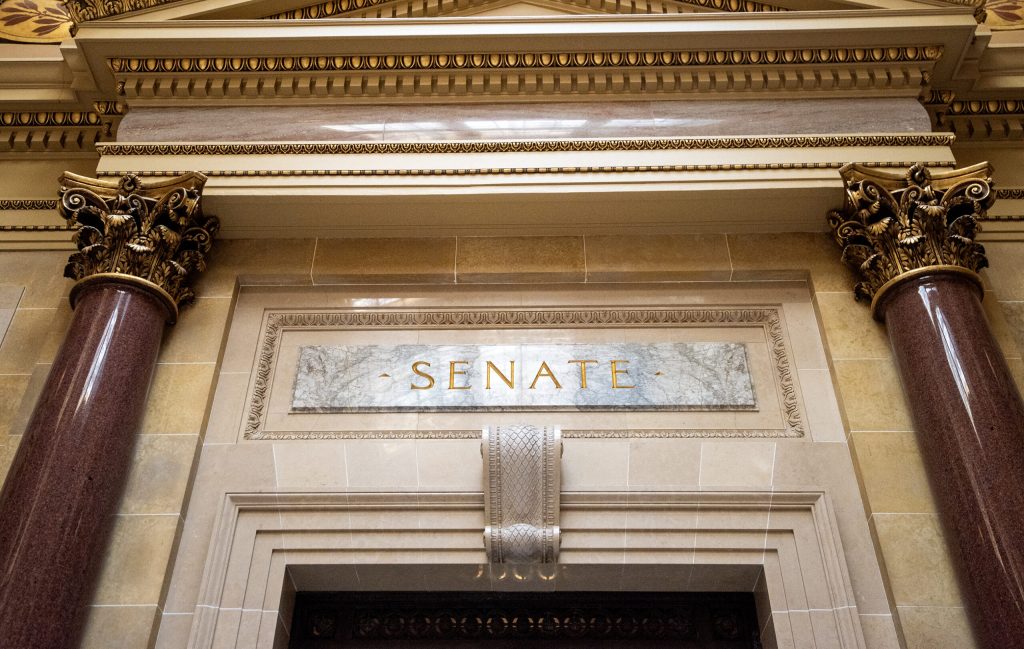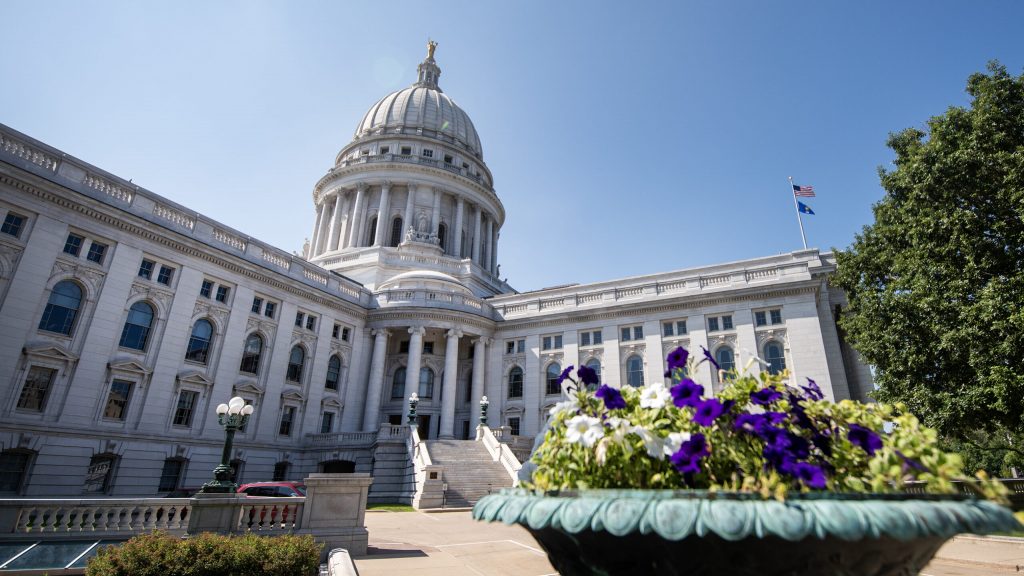Fight for Control of Wisconsin Senate Has Begun
2026 election gives Democrats a chance to flip seats under new legislative maps.

The door to the Wisconsin State Senate on Monday, July 14, 2025, at the Wisconsin State Capitol in Madison, Wis. Angela Major/WPR
With well over a year to go before the 2026 election, Wisconsin Democrats have launched their first campaigns aimed at winning control of the state Senate, focusing on a handful of seats that were made competitive under new legislative maps.
The November election was the first test for the new maps, which helped Democrats whittle a Republican supermajority of 22-10 down to an 18-15 split. Those pickups came despite President Donald Trump defeating former Vice President Kamala Harris in the state.
Democrats now only need to pick up a net gain of two Senate seats to win a majority in that chamber.
An analysis by Marquette University Law School researcher John Johnson suggests there are four “battleground” state Senate districts in play ahead of the 2026 midterm elections.
They include:
- The 5th Senate District held by Sen. Rob Hutton, R-Brookfield
- The 17th Senate District held by Sen. Howard Marklein, R-Spring Green
- The 21st Senate District held by Sen. Van Wanggaard, R-Racine
- The 31st Senate District held by Sen. Jeff Smith, D-Brunswick
“The good news for Democrats is that I would say all four of these seats lean Democratic, even though three of them have Republican incumbents,” Johnson told WPR. “I say that because not only did (Democratic U.S. Sen.) Tammy Baldwin win a majority of the vote in each of these districts in her 2024 senatorial reelection campaign, so did Kamala Harris, even though she lost the state.”
Of the four Senate seats seen as most competitive next year, Democrats consider the 5th Senate District, currently held by Hutton, as the most “flippable” in the state.
When she announced her campaign to challenge Hutton, state Rep. Robyn Vining, D-Wauwautosa, was flanked by fellow Democrats including Senate Minority Leader Dianne Hesselbein, D-Middleton. In a statement, Hesselbein said “the road to a Democratic Majority” runs through Wisconsin’s 5th Senate District.
He said the current maps give Democrats “a real strong chance” to flip it during the midterms, which historically favor the party not in the White House.
“The 5th is one where I think Democrats will be having a pretty bad night if they don’t win it,” Johnson said. “You know, if they lose the 5th, that’ll suggest that they’ve probably lost those other targets, too.”
Early fundraising reports show Hutton has around $90,000 in campaign cash in the bank, while Vining reported having around $22,000 cash on hand.
In a separate announcement earlier this month, Wisconsin Rep. Jenna Jacobson, D-Oregon, announced her campaign to unseat Marklein, who co-chairs the Legislature’s powerful Joint Finance Committee. Just as with Vining’s campaign launch, Jacobson was flanked by Senate Democrats, including Hesselbein. Johnson’s analysis shows Harris only beat Trump by 1 percentage point in Marklein’s district.
Jacobson’s first campaign finance report shows she’s only raised around $1,700 thus far and has about $387 in the bank. Another candidate, Lisa White of Petosi, also announced a challenge against Marklein. So far, White has raised around $15,000 and has about $6,500 in the bank.
Marklein’s fundraising this year has far outpaced both of his contenders. As of June 30, the Republican raised around $67,000 and reported having around $571,000 in the bank.
Those numbers could eventually pale in comparison to what the candidates receive from Wisconsin’s political parties, which have the power to accept unlimited donations and make unlimited transfers under state law.
So far, Democrats have yet to announce a challenger against Wanggaard, who has yet to announce whether he’s running. Wanggaard’s campaign finance report showed he raised a total of 80 cents in the first half of this year.
Wisconsin Democrats playing early defense in 31st Senate District
The latest fundraising reports show state Democrats are playing defense in western Wisconsin’s 31st Senate district, currently held by Smith, even though no Republican has entered the race. Smith’s campaign raised around $67,000, which includes thousands in transfers from Democrats sitting in safer districts under the new maps.
“So, I think part of the reason why you might see those transfers — even though I believe there’s not a Republican who’s declared for that race yet — is trying to put Jeff Smith in a strong position so that prospective challengers might see his war chest and decide not to run against him,” Johnson said.
In addition to the fight for the Senate, both parties will vie for control of the state Assembly. In that chamber, Democrats picked up 10 seats last year under the new maps, though Republicans retained a 54-45 advantage.
Fight for control of Wisconsin Senate is shaping up ahead of 2026 election was originally published by Wisconsin Public Radio.
If you think stories like this are important, become a member of Urban Milwaukee and help support real, independent journalism. Plus you get some cool added benefits.























Praying for a change!
Exciting possibilities ahead!